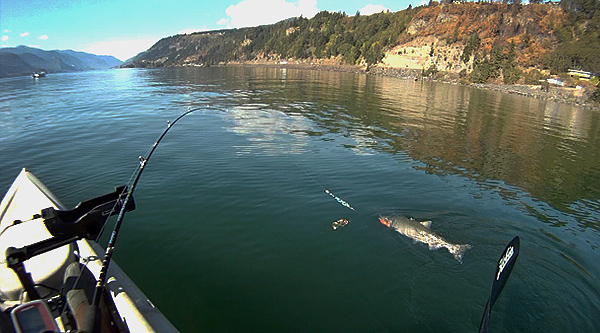Columbia River King Salmon Fishing in 2023
Columbia River king salmon fishing is looking excellent this 2023! Born Oregon and Washington fish managers are expecting a large run of salmon heading to the Columbia River and its tributaries this year, predicting that about 3-7,800 hatchery and wild salmon are returning to the river.

This will have any angler excited because last year’s spring salmon run was expected to be around 197,000 to the Columbia River but was almost 275,000. If the predictions are correct, this 2023 will have the biggest return of salmon entering the Columbia River since 2015, so you can expect excellent Columbia River king salmon fishing! But of course, you will still need to prepare well to reel in a catch successfully.
Read on for our ultimate guide on catching salmon in the Columbia River this 2023.
Columbia River King Salmon Fishing in 2023
There are various salmon species you can choose from, including coho salmon, sockeye salmon, and of course chinook salmon, which is also known as “Kings.”

While coho and sockeye salmon are quality catches, there is a reason why they are called kings, being the cream of the crop in Columbia River’s fishing scene. Three king salmon runs grace the waters every year, boasting some of the biggest and most delicious variations worldwide.
But how can you catch them? Here are the things you should know when it comes to Columbia River king salmon fishing:
When to Go Columbia River King Salmon Fishing

King salmon season generally begins in March, once the spring run enters the river. At this time, the fish would weigh around 15-25 pounds. Sure, they may not be the largest, but they are considered the best in terms of meat. That’s why you find anglers heading to the Columbia River at this time because this is when the tasty fish head to the waters.
The fishing season for kinds continues through summer when the second run enters the waters in June. Now, this is when the big guns come along, weighing between 40-50 pounds. In fact, kings at this time are called the “June Hogs!” Expect excellent fishing action and put up a fight.
The final run occurs in the fall, starting in August. Returning Chinook will make their way from the ocean into the Columbia River. You get a wide range of sizes, weighing anywhere between 25-50 pounds. Moreover, they will be delicious!
Columbia River King Salmon Fishing Techniques
Before we discuss the optimum Columbia River king salmon fishing techniques, we first want to mention that it is possible to catch salmon either on a boat or foot. That said, with the Columbia River’s sheer size, you may be better off joining a fishing charter to cover more ground. Charter captains and guides will also help navigate the waters and teach you the techniques we will discuss below.
Trolling

Trolling is the most popular and commonly used technique when catching salmon, and for a great reason! This technique will have you drop multiple lines, thus covering a large span of water. That means you can entice even more fish into biting. While you must be on a boat to use this technique, it will be worth it.
An effective way to lure king salmon into biting is by using herring. Some anglers prefer using whole bait fish, which means combining it with a bait clip with a fin. That way, your bait will move underwater.
Other anglers may use cut herring, which would spin well in the water, attracting salmon’s attention. Combine that with a plug to have your bait look like an injured fish.
If you prefer using artificial, you can find success with spinners.
As for your rods and reels, use a longer rod measuring about 9-10 feet. You would also want the rod to withstand a lot of weight, preferably between 12-20 ounces. Pair that with a stand 30-lb monofilament line to cope with big fish bites. Alternatively, a 65-lb braided line works if you prefer a tougher tackle. Because king salmon like traveling to the deep, prepare 12-16 oz weights.
Spinning
Spinning is more of an umbrella term associated with any fishing technique involving the basic rod, reel, and chosen casting motion. As such, you can experience this technique in various ways.
A popular technique is plunking, which is when you will cast your line in a king salmon hotspot, particularly around the migratory route, then wait it out. It will also involve using an 8-9′ extra-heavy rod and 40-60-lb braided line with bait fish. Most anglers use a kwikfish lure wrapped in herring.
Moreover, you will need a three-way swivel, which allows you to add your lure or baitfish on one side, then your weight on the other. You can use 2-10-lb weights, with the line being the main tie line to the swivel that has a snap link tied at the end. Ass a 12-15-lb dropper line measuring around 15-20 inches, which should also have a snap link at the end. If you prefer using monofilament, use 25-lb.
Back bouncing is also a popular choice, which takes place on a boat so you get to reach deeper waters. This technique involves a medium-heavy 8-9′ rod that’s made for hovering or back bouncing. Pair your rod with a 30-50-lb braided line. As for your setup, attach a swivel to the main line, then a 3-5′ leader that weights 25-60 lbs. then, tie a 6-25′ test line weighing about 12 pounds to use as a dropper line with a dropper or cannonball-style sinker at the end.
Wrapping It Up

We hope that this guide to Columbia River king salmon fishing helped you out! Now that you know more about how to catch these species, it’s time to prepare for the other aspects of your trip, including where to book your charter!
If you’re still on the lookout for a reputable fishing charter in Columbia River, contact us now. We’ll connect you with our network of excellent charter captains.
